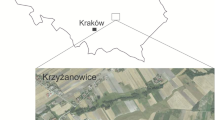Summary
On Ile de la Possession, as on all the subantarctic islands, major compounds of organic nutrients are provided by avifauna. The presence of Wandering Albatrosses (Diomedea exulans) induces great perturbations in the environment at the site of their nest building activities: physical and chemical modifications of the soil (by removal of litter material for nest building, trampling and accumulated organic deposits) as well as microbiological, botanical and faunal changes. These perturbations are very localized in extent. The pedological changes have been described in terms of morphological modifications. The influence of Wandering Albatrosses on the vegetation and the invertebrate fauna has been assessed and shows a decrease in the number of plant species and an increase in the number of invertebrate species. The role of some of these as indicator species is discussed.
Similar content being viewed by others
References
Allen SE, Northover MJ (1967) Soil types and nutrients on Signy Island. Philos Trans R Soc London Ser B 777:179–185
Augier J (1966) Flore des bryophytes. Paul Lechevalier, Paris, 702 pp
Barrat A, Barré H, Mougin JL (1976) Données écologiques sur les Grands Albatros Diomedea exulans de l'Ile de la Possession (archipel Crozet). L'Oiseau R F O 46:143–155
Bates JW, Brown DH (1975) The effect of seawater on the metabolism of some seashore and inland mosses. Oecologia (Berlin) 21:235–244
Braun-Blanquet J (1964) Pflanzensoziologie. Grundzüge der Vegetationskunde, 3. Aufl. Springer, Wien, 865 pp
Callaghan TV, Collins NJ (1976) Strategies of growth and population dynamics of tundra plants. Oikos 27:383–388
Chapin FS, Bloom A (1976) Phosphate absorption: adaptation of tundra graminoids to a low temperature, low phosphorus environment. Oikos 27:111–121
Chessel D, Donadieu P (1977) Introduction à l'étude de la structure horizontale en milieu steppique. III. Dispersion locale, densité et niveau d'implantation. Oecol Plant 12:221–240
Croxall JP (1979) Distribution and population changes in the Wandering Albatross Diomedea exulans at South Georgia. Ardea 67:15–21
Frenot Y (1986) Interactions entre la faune lombricienne et les systèmes édaphiques d'une île subantarctique: Ile de la Possession, archipel Crozet. Thèse Doctorat de l'Université de Rennes I (unpublished), 357 pp
Fressanges du Bost D, Segonzac M (1976) Note complémentaire sur le cycle reproducteur du Grand Albatros Diomedea exulans de l'Ile de la Possession, archipel Crozet. C N F R A 40:53–60
Gillham ME (1956) Manuring by the colonial seabirds and mammals with a note on seed distribution by gulls. J Ecol 44:429–454
Gillham ME (1961) Modification of Sub-Antarctic flora on Macquarie island by sea birds and sea elephants. Proc R Soc Victoria, New Ser 74:1–12
Gremmen NJM (1982) The vegetation of the subantarctic islands Marion and Prince Edward. W Junk, The Hague, 145 pp
Hogg EH, Morton JK (1983) The effects of nesting gulls on the vegetation and soil of islands in the Great Lakes. Can J Bot 61:3240–3254
Huntley BJ (1971) Vegetation. In: Van Zinderen Bakker EM Jr, Winterbottom JM, Dyer RA (eds) Marion and Prince Edward Islands; Rep South Afr Biol Geol Exp 1965–1966. A A Balkema, Cape Town, pp 88–160
Lindeboom H (1979) Chemical and microbiological aspects of the nitrogen cycle on Marion Island (Sub-Antarctic). Ph D Thesis, University of Groningen, 138 pp
Malmer N, Nihlgård B (1980) Supply and transport of mineral nutrients in a subarctic mire. Ecol Bull (Stockholm) 30:63–95
Mougin JL (1970) Observations écologiques sur les Grands Albatros (Diomedea exulans) de l'Ile de la Possession (archipel Crozet) en 1968. L'Oiseau R F O (spécial): 40:16–36
Osborne BA, Whittington WJ (1981) Ecophysiological aspects of interspecific and seasonal variations in nitrate utilization in the genus Agrostis. New Phytol 87:595–614
Smith RIL (1981) Types of peat-forming vegetation on South-Georgia. Br Antarct Surv Bull 53:119–139
Smith RIL (1985) Nutrient cycling in relation to biological productity in Antarctic and Sub-Antarctic terrestrial and freshwater ecosystems. In: Siegfried WR, Condy PR, Laws RM (eds) Antarctic nutrient cycling and food webs. Springer, Berlin, pp 138–155
Smith VR (1976a) The nutrient statuses of Marion Island plants and soils. Ph D Thesis, University of Bloemfontein, South Africa, 135 pp
Smith VR (1976b) The effect of burrowing species of Procellaridae on the nutrient status of inland grasslands on Marion Island. J S Afr Bot 42:265–272
Smith VR (1977a) The chemical composition of Marion Island soils, plants and vegetation. S Afr J Antarct Res 7:28–39
Smith VR (1977b) A qualitative description of energy flow and nutrient cycling in the Marion Island terrestrial ecosystem. Polar Rec 18:361–370
Smith VR (1978) Animal-soil-plants nutrient relationships on Marion Island (Subantarctic). Oecologia (Berlin) 32:239–253
Smith VR (1979) The influence of seabird manuring on the phosphorous status of Marion Island (Subantarctic) soils. Oecologia (Berlin) 41:123–126
Taylor BW (1955) The flora, vegetation and soils of Macquarie Island. ANARE Rep, Ser B 2:1–192
Tickell WLN (1968) The biology of the Great Albatrosses, Diomedea exulans and epomophora. In: Antarctic bird studies, Antarct Res Ser, vol 12. American Geophysical Union, Washington, pp 1–55
Tréhen P, Bouché MB, Vernon Ph, Frenot Y (1985) Organization and Dynamics of the oligochaeta and diptera populations on Possession Island. In: Siegfried WR, Condy PR, Laws RM (eds) Antarctic nutrient cycles and food webs. Springer, Berlin, pp 606–613
Van Zinderen Bakker EM Jr (1971) The Genus Diomedea. In: Van Zinderen Bakker EM Jr, Winterbottom JM, Dyer RA (eds) Marion and Prince Edward Islands; Rep South Afr Biol Geol Exp 1965–1966. A A Balkema, Cape Town, pp 273–282
Vernon Ph (1981) Peuplement diptérologique des substrats enrichis en milieu insulaire subantarctique (Iles Crozet); Etude des Sphaeroceridae du genre Anatalanta. Thèse Université de Rennes (unpublished), pp 110
Voisin JF (1966) L'Albatros hurleur Diomedea exulans à l'Ile de la Possession. L'Oiseau R F O (spécial) 39:82–106
Author information
Authors and Affiliations
Rights and permissions
About this article
Cite this article
Joly, Y., Frenot, Y. & Vernon, P. Environmental modifications of a subantarctic peat-bog by the Wandering Albatross (Diomedea exulans): A preliminary study. Polar Biol 8, 61–72 (1987). https://doi.org/10.1007/BF00297166
Received:
Accepted:
Issue Date:
DOI: https://doi.org/10.1007/BF00297166




